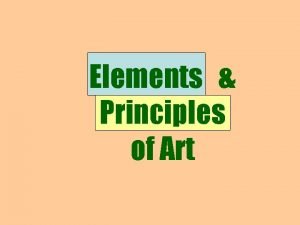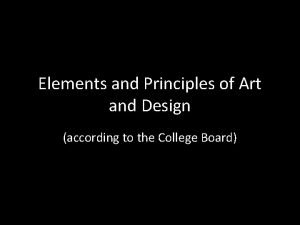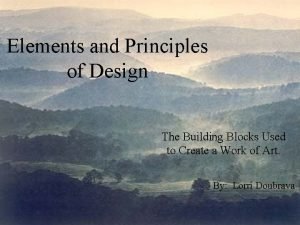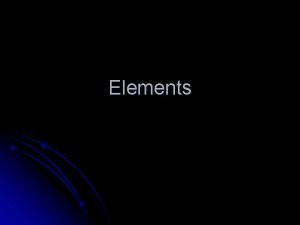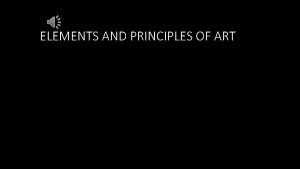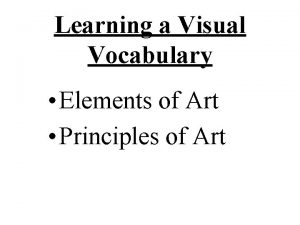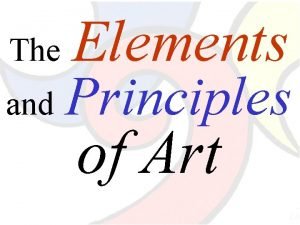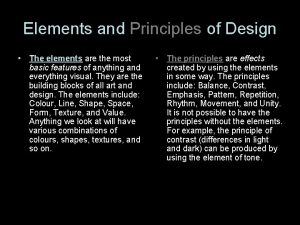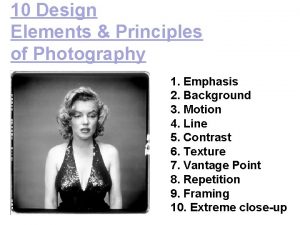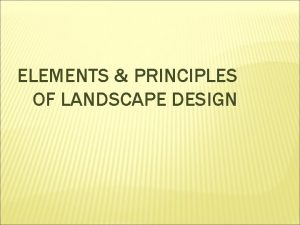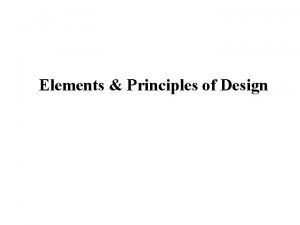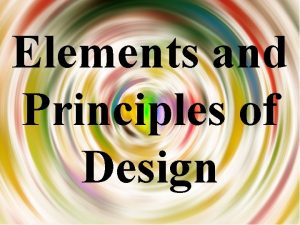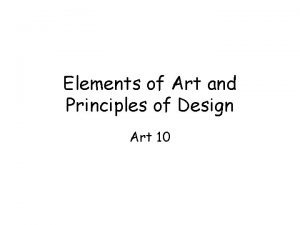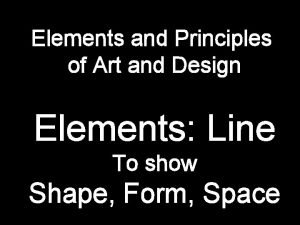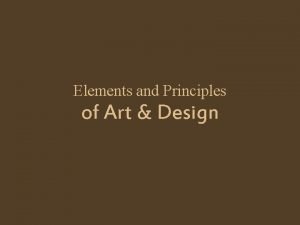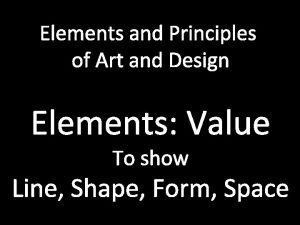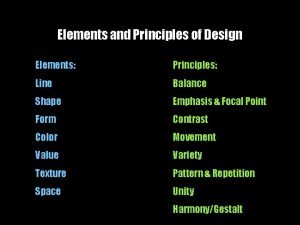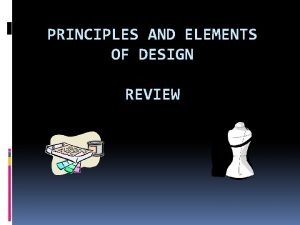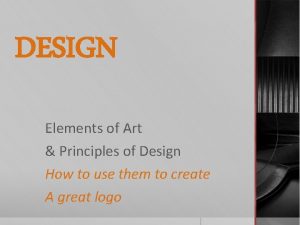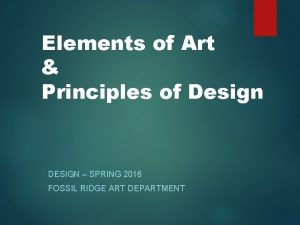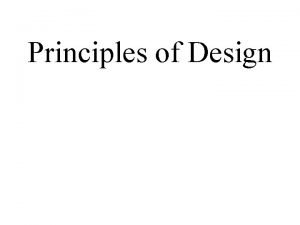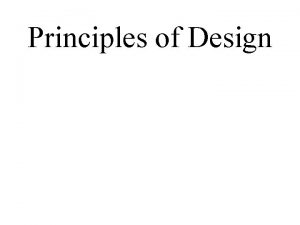Elements Principles of Design The ELEMENTS of art
























- Slides: 24

Elements & Principles of Design

The ELEMENTS of art: line, shape, form, color, value, texture and space.

1) Line • “a dot that moves” or “continuous mark” • Describes a shape or outline. • It can be: straight, curved, vertical, horizontal, jagged, or dotted

The ELEMENTS of art: Line …a dot that moves…. defines space, contours and outlines, or suggests mass and volume. Straight, curved, vertical, horizontal, jagged, dotted Vincent van Gogh Cottage Garden 1888 reed pen, quill, and ink over graphite on wove paper, 24 x 19 -1/4 inches Private Collection, Courtesy Metropolitan Museum of Art Dominance Portfolio, Blue, Bridget Riley, 1977

2) Shape • An enclosed space defined by other art elements such as line, color and texture. • Shapes can be geometric or organic. – Geometric: Circles, squares, rectangles , triangles. Seen in architecture, manufactured items. – Organic: Leafs, seashells, flowers. Seen in nature; free flowing and irregular shapes.

The ELEMENTS of art: shape An enclosed space defined by other art elements such as line, color and texture. May be geometric or organic Dogs, MC ESCHER, 1938 Cycle, MC ESCHER, 1938

Positive and Negative Shapes • Positive Shapes are the solid forms in a design such as a bowl of fruit. In a sculpture it is the solid form of the sculpture. • Negative Shapes-In a drawing it is the space around the positive shape or the shape around the bowl of fruit. In sculpture it is the empty shape around and between the sculptures.

3) Form • Appears 3 -dimensional (3 D) such as a cube, sphere, pyramid or cylinder. • Shape is only two-dimensional; form is threedimensional. You can hold a form; walk around a form • Form can also be geometric or organic.

The ELEMENTS of art: form Are these forms organic or geometric? Where is the positive and negative shapes? CLOUD GATE, Chicago , Anish Kapoor Midsummer Snowballs, Andy Goldsworthy SNOWBALL, Andy Goldsworthy

Organic or Geometric Forms? Alexander Calder’s MOBILE at the National Gallery of Art The ELEMENTS of art: form White Vertical Water, 1972 Louise Nevelson

4) Color • Color Theory Power. Point and Color Wheel

The ELEMENTS of art: color Complementary, Cool, Warm Color Schemes Yellow and blue accentuate each other in van Gogh’s Café Terrace on the Place du Forum, Arles, 1888 Red and green accentuate each other in van Gogh’s Night Café in Arles, which was painted the same month as the café at left

5) Value • Refers to the light and dark areas of a picture. • Value creates depth within a picture making an object look three dimensional (3 D) with highlights and cast shadows.

Categories of Value • Tint is adding white to create lighter values such as light blue or pink. • Shade is adding black to create dark values such as dark blue or dark red. • Value Scale is a scale that shows the gradual change in value from its lightest value, white to its darkest value black.

The ELEMENTS of art: value Refers to the light and dark areas of an art work

The ELEMENTS of art: value Study of Arms and Hands, Da Vinci 1474

El Greco: Allegory, Boy Lighting Candle in the Company of an Ape and a Fool The ELEMENTS of art: value

The ELEMENTS of art: value THE MILKMAID (De Melkmeid ) c. 1658 -1661 oil on canvas 17 7/8 x 16 1/8 in. (45. 5 x 41 cm. ) The Rijksmuseum, Amsterdam

6) Texture • The surface quality • A rock may be rough and jagged. A piece of silk may be soft and smooth and your desk may feel hard and smooth. • Texture also refers to the way a picture is made to look rough or smooth.

The ELEMENTS of art: texture The surface quality of an artwork usually perceived through the sense of touch. Texture may also be implied. SURFACE is polished marble, simulated texture of flesh and fabric Pietà Michelangelo, 1499 Marble

The ELEMENTS of art: texture Shoes, 1888 Vincent van Gogh (Dutch, 1853– 1890) Oil on canvas; 18 x 21 3/4 in. Vincent van Gogh (Dutch, 1853– 1890) Sunflowers 1887 Medium Oil on canvas 17 x 24 in. (43. 2 x 61 cm)

6) SPACE • The distance around, between, above, below, and within an object. • Categories of Space – Positive Space (similar to positive shape) – Negative Space (similar to negative shape) – Composition: organization of elements in artwork – Focal Point

The ELEMENTS of art: space The distance around, between, above, below, and within an object. NEGATIVE SPACE OR POSITIVE SPACE Fallingwater is the name of a very special house that is built over a waterfall. Frank Lloyd Wright, America’s most famous architect, designed the house for his clients, the Kaufmann family. Fallingwater was built between 1936 and 1939. It instantly became famous, and today it is a National Historic Landmark.

 Line shape form color texture space
Line shape form color texture space Types of emphasis in art
Types of emphasis in art Elements principles of art
Elements principles of art Principles of art
Principles of art Elements and principles of art
Elements and principles of art Progressive rhythm in art
Progressive rhythm in art Balance and rhythm in art
Balance and rhythm in art Visual elements
Visual elements Arts elements and principles
Arts elements and principles Art vocabulary elements and principles
Art vocabulary elements and principles Principles of art
Principles of art Connesct
Connesct Horizontal lines in hair
Horizontal lines in hair Curved lines can be placed horizontally vertically
Curved lines can be placed horizontally vertically Tension in floral design
Tension in floral design Elements and principles of design chart
Elements and principles of design chart Principles of interior design ppt
Principles of interior design ppt Visual elements and principles of design matrix
Visual elements and principles of design matrix Elements and principles of design fashion
Elements and principles of design fashion Design elements and principles of the universe
Design elements and principles of the universe Photography elements and principles
Photography elements and principles Elements and principles of architecture
Elements and principles of architecture Elements and principles of landscape design
Elements and principles of landscape design What are the elements and principles of design
What are the elements and principles of design Christina's world
Christina's world


